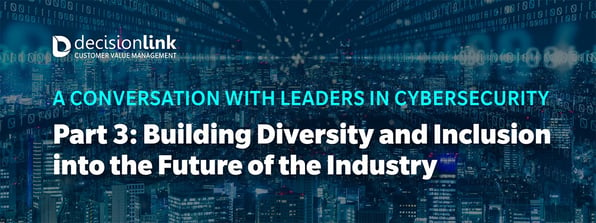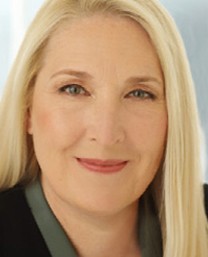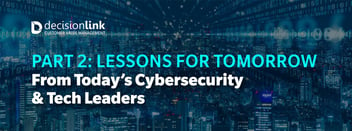A Conversation with Leaders in Cybersecurity Part 3

While the world of cybersecurity has undergone a complete transformation in the last 20 years, some aspects of the industry remain unchanged. Women are still underrepresented in the IT workforce—especially at the top. In the final installment of our three-part women in cybersecurity and tech webinar series, we spoke with a panel of seasoned executives about the quantifiable value of cybersecurity, how women can overcome common challenges, and ways to make the tech environment more inviting for career starters. Here are the top takeaways from these thought leaders. (Be sure to read part one and part two, if you haven’t already.)
#1 CYBERSECURITY BUSINESS VALUE: HOW MUCH IS YOUR COMPANY WORTH?
Here at DecisionLink, we talk a lot about quantifying business value because that’s how we help customers close more deals at a higher level. But how can you put a dollar amount on something as enormous and variable as cybersecurity? According to Kavitha Mariappan, EVP of Customer Experience and Transformation at Zscaler, you absolutely can quantify security: “What’s the potential cost of a breach? Millions or even billions of dollars. Conversely, what’s the value of the peace of mind that comes with knowing your organization is protected again the newest cyberattacks? I’d say it’s immeasurable.”
With the cyberthreat landscape becoming increasingly complex, accelerated, and unrelenting, the risk goes beyond technology and operations. Threats can impact your company as a whole as well as your shareholders, partners, customers, and community. Leaders have a responsibility to protect not just the corporate brand but also critical services, infrastructure, and public health and safety by doing their utmost to understand and mitigate those risks.
The network environment today is nothing like it was 20 years ago. Every endpoint is another way in. Debra Danielson, CTO of Digital Guardian, explains, “It’s an asymmetric conflict. Hackers only have to find one viable vulnerability, whereas your security team has to be perfect if you’re relying on them to harden the perimeter.” According to Kavitha Mariappan, relying on legacy security infrastructures to protect a modern, hybrid application landscape against sophisticated threat actors is like “putting locks on the doors but leaving the windows open.” Debra Danielson adds, “Getting in is only part of the equation. The real damage is done when data is infiltrated or made unavailable. That’s where it becomes all about the business.” And that’s where the value of cybersecurity is immense.
#2 TO CHANGE THE WORKFORCE, CHANGE THE ENVIRONMENT
Clare Cunniffe, Senior Area Sales Director for Strategic Accounts East at Okta, says, “I wish I could say that 20 years after I entered the industry the number of women in tech and security is increasing, but unfortunately I’m not seeing that.” However, she sees diversity as vital to success—especially in the world of security. “Cybersecurity is not a problem you can solve if you’re only looking at it from one angle. Women bring a lot of perspective to the industry, and we need more of that. We need many different ways of looking at things.”
Maria Klawe, renowned scholar, computer scientist, and advocate, has been influential in increasing the representation of women in STEM. As president of Harvey Mudd College, Maria has made diversity a priority, taking steps to make science and engineering more appealing to women. She leveled the playing field in computer science 101 by separating digital natives from coding newbies and those just exploring their options. She also changed the physical environment, doing away with the stereotypical “basement lab that smells like a gym bag” by adding comfortable furniture and color to the walls. And finally, she brought in a broader set of problems to frame computer science, which allows more people to connect what’s important to them with the impact of coding. As a result of Maria’s efforts, women now make up over 50% of the student body compared to just 30% when she started. The key is not just implementing change, but institutionalizing it.
“It’s hard to hire women in security because not many women work in security, so there are no role models. We need to disrupt this cycle.”
DEBRA DANIELSON
CTO of Digital Guardian
#3 FUTURE FOCUS: HOW TO BRING MORE WOMEN TO THE TABLE
According to Kavitha Mariappan, there’s an urgent need in the industry to change the corporate culture that continues to “foster and sustain” stereotypes about women—and not just because it’s the right thing to do. A recent Boston Consulting Group study found that more diverse companies produce more innovation revenue. Kavitha says, “As a corporate leader, a woman in tech, and a mother of three daughters, I don’t want us to have a seat at the table. I want us to have many seats at the table. But first we have to break down the myths and the barriers.”
For young women looking to begin a career in tech, our panelists agree that there’s one key incentive that no one is talking about: income. “The opportunities for a career in STEM are substantial, exciting, interesting,” says Kavitha. “It’s not just about tinkering—tech controls the world today. This means there’s a huge opportunity for wealth.” With women being disproportionately represented in lower-paying professions, cybersecurity and tech offer a road to economic independence. According to Debra Danielson, “These are good, high-paying jobs and women are not participating at the same level that men are.”
Kavitha Mariappan also notes that there’s a “leaky pipeline” for females between school and the C-suite because they’re more likely than their male counterparts to be sidelined by their home lives. To counter this, Clare Cunniffe says women need to create stronger networks and sustain them throughout their career path. “This is such an important piece of the puzzle,” she says, “women not only helping younger women enter the field but also supporting those who are already in the field, so they can stay.” And we need to stop teaching girls that they have to be perfect. To succeed in the tech industry while also having a rich personal life, women need to prioritize what’s important to them and outsource what’s not. Debra Danielson sums it up: “You can’t be perfect in every aspect of your life. Choose what you want to do and make it work.”
This just scratches the surface of the insights shared in the session. To learn more about the panel’s perspectives on the future of women in tech, watch the full webinar. Don’t forget to check out part one and part two to learn from all the ground-breaking leaders we had the honor of speaking with.
GET TO KNOW OUR PANELISTS:

Clare Cunniffe is Senior Area Sales Director for Strategic Account East for Okta, the leading independent identity provider, and has 30+ years’ experience in the cybersecurity space.

Debra Danielson is Chief Technology Officer at Digital Guardian and a passionate advocate for accelerating value creation by leveraging technology and inspiring talent.

Karen Escoffery is a Cybersecurity Account Executive, and has over 30 years in the cybersecurity and tech space.

Kavitha Mariappan is Executive Vice President of Customer Experience and Transformation at Zscaler and an experienced go-to-market executive

Georgeanna Westmoreland is the facilitator of our webinar and DecisionLink’s Sales Director.

 ValueCloud
ValueCloud
.png?width=118&height=76&name=Rectangle%20(3).png) ValueCloud Ignite
ValueCloud Ignite
.png?width=92&height=92&name=Rectangle%20(4).png) Free Assessment
Free Assessment
.png?width=100&height=100&name=Rectangle%20(5).png) Watch a Demo
Watch a Demo
.png?width=82&height=96&name=Rectangle%20(6).png) Value Calculator
Value Calculator

.png?width=62&height=51&name=Group%2010%20(1).png) Marketing
Marketing
 Sales
Sales
 Customer Success
Customer Success
 Engage Prospects
Engage Prospects
 Win Deals Faster
Win Deals Faster
 Retain Customers
Retain Customers
.png?width=62&height=62&name=Rectangle%20(8).png) Adopt and Scale
Adopt and Scale
.png?width=54&height=54&name=Rectangle%20(9).png) Cybersecurity
Cybersecurity
 Healthcare
Healthcare
.png?width=54&height=54&name=Rectangle%20(10).png) IT & Software
IT & Software



